recommended oil FORD F650 2011 12.G Owners Manual
[x] Cancel search | Manufacturer: FORD, Model Year: 2011, Model line: F650, Model: FORD F650 2011 12.GPages: 290, PDF Size: 1.96 MB
Page 106 of 290
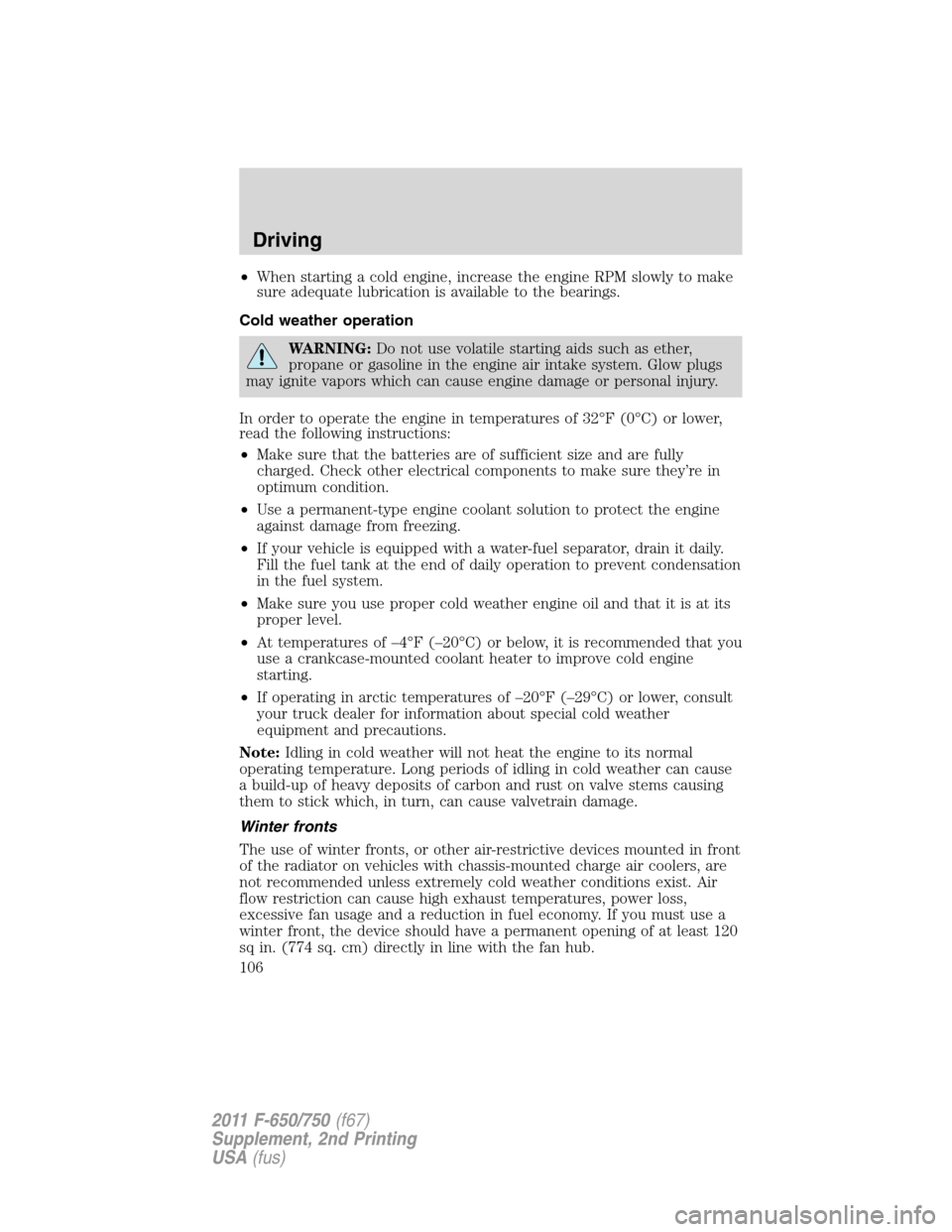
•When starting a cold engine, increase the engine RPM slowly to make
sure adequate lubrication is available to the bearings.
Cold weather operation
WARNING:Do not use volatile starting aids such as ether,
propane or gasoline in the engine air intake system. Glow plugs
may ignite vapors which can cause engine damage or personal injury.
In order to operate the engine in temperatures of 32°F (0°C) or lower,
read the following instructions:
•Make sure that the batteries are of sufficient size and are fully
charged. Check other electrical components to make sure they’re in
optimum condition.
•Use a permanent-type engine coolant solution to protect the engine
against damage from freezing.
•If your vehicle is equipped with a water-fuel separator, drain it daily.
Fill the fuel tank at the end of daily operation to prevent condensation
in the fuel system.
•Make sure you use proper cold weather engine oil and that it is at its
proper level.
•At temperatures of –4°F (–20°C) or below, it is recommended that you
use a crankcase-mounted coolant heater to improve cold engine
starting.
•If operating in arctic temperatures of –20°F (–29°C) or lower, consult
your truck dealer for information about special cold weather
equipment and precautions.
Note:Idling in cold weather will not heat the engine to its normal
operating temperature. Long periods of idling in cold weather can cause
a build-up of heavy deposits of carbon and rust on valve stems causing
them to stick which, in turn, can cause valvetrain damage.
Winter fronts
The use of winter fronts, or other air-restrictive devices mounted in front
of the radiator on vehicles with chassis-mounted charge air coolers, are
not recommended unless extremely cold weather conditions exist. Air
flow restriction can cause high exhaust temperatures, power loss,
excessive fan usage and a reduction in fuel economy. If you must use a
winter front, the device should have a permanent opening of at least 120
sq in. (774 sq. cm) directly in line with the fan hub.
Driving
106
2011 F-650/750(f67)
Supplement, 2nd Printing
USA(fus)
Page 193 of 290
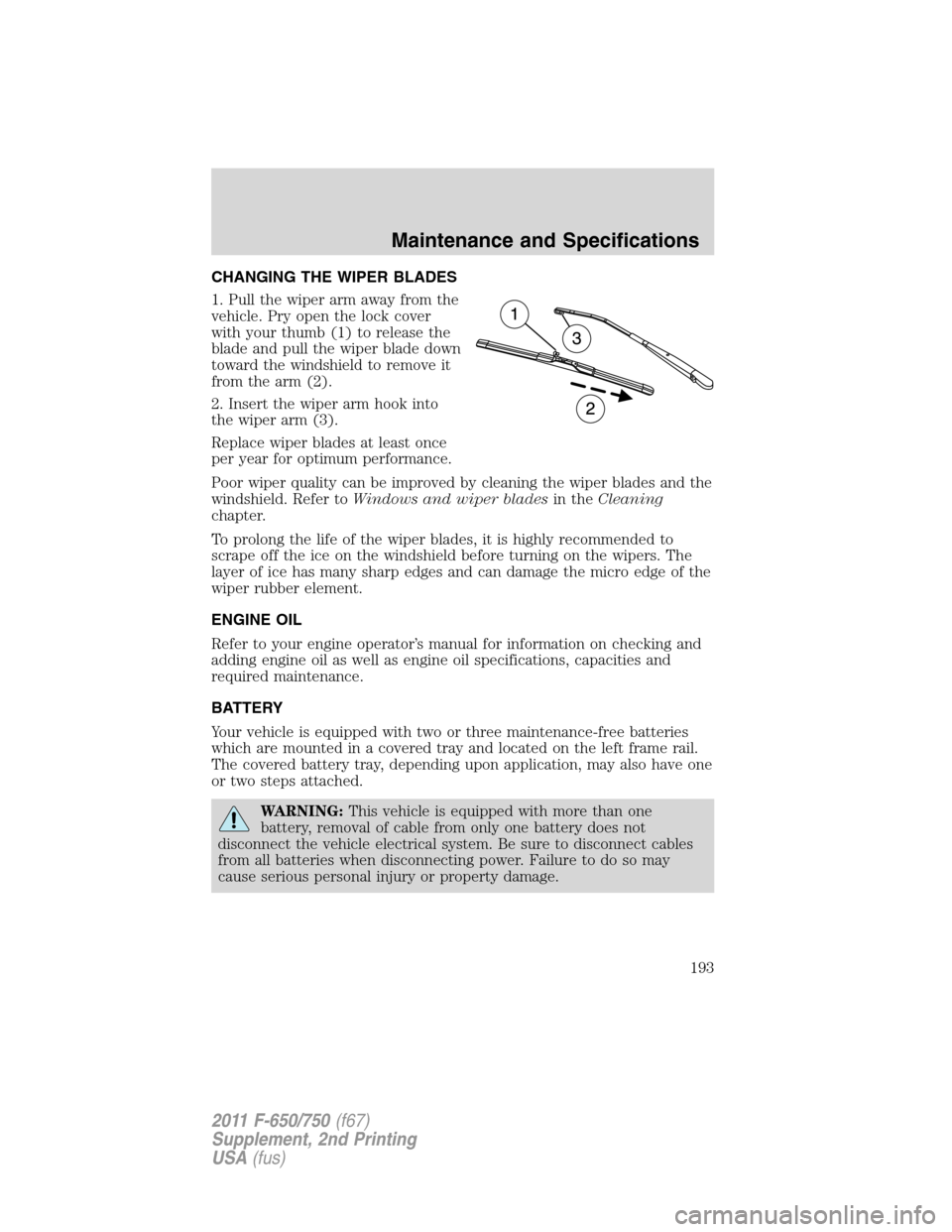
CHANGING THE WIPER BLADES
1. Pull the wiper arm away from the
vehicle. Pry open the lock cover
with your thumb (1) to release the
blade and pull the wiper blade down
toward the windshield to remove it
from the arm (2).
2. Insert the wiper arm hook into
the wiper arm (3).
Replace wiper blades at least once
per year for optimum performance.
Poor wiper quality can be improved by cleaning the wiper blades and the
windshield. Refer toWindows and wiper bladesin theCleaning
chapter.
To prolong the life of the wiper blades, it is highly recommended to
scrape off the ice on the windshield before turning on the wipers. The
layer of ice has many sharp edges and can damage the micro edge of the
wiper rubber element.
ENGINE OIL
Refer to your engine operator’s manual for information on checking and
adding engine oil as well as engine oil specifications, capacities and
required maintenance.
BATTERY
Your vehicle is equipped with two or three maintenance-free batteries
which are mounted in a covered tray and located on the left frame rail.
The covered battery tray, depending upon application, may also have one
or two steps attached.
WARNING:This vehicle is equipped with more than one
battery, removal of cable from only one battery does not
disconnect the vehicle electrical system. Be sure to disconnect cables
from all batteries when disconnecting power. Failure to do so may
cause serious personal injury or property damage.
Maintenance and Specifications
193
2011 F-650/750(f67)
Supplement, 2nd Printing
USA(fus)
Page 199 of 290
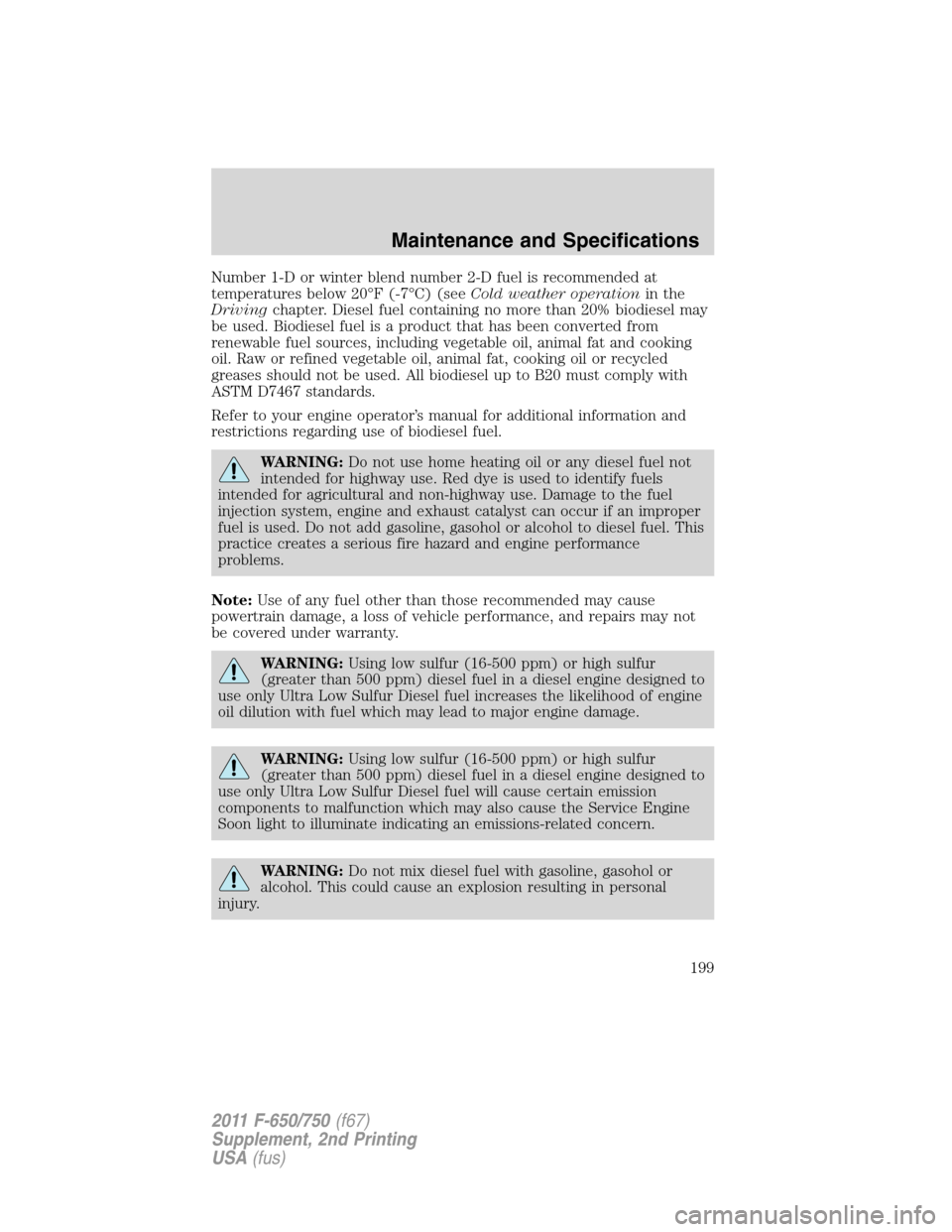
Number 1-D or winter blend number 2-D fuel is recommended at
temperatures below 20°F (-7°C) (seeCold weather operationin the
Drivingchapter. Diesel fuel containing no more than 20% biodiesel may
be used. Biodiesel fuel is a product that has been converted from
renewable fuel sources, including vegetable oil, animal fat and cooking
oil. Raw or refined vegetable oil, animal fat, cooking oil or recycled
greases should not be used. All biodiesel up to B20 must comply with
ASTM D7467 standards.
Refer to your engine operator’s manual for additional information and
restrictions regarding use of biodiesel fuel.
WARNING:Do not use home heating oil or any diesel fuel not
intended for highway use. Red dye is used to identify fuels
intended for agricultural and non-highway use. Damage to the fuel
injection system, engine and exhaust catalyst can occur if an improper
fuel is used. Do not add gasoline, gasohol or alcohol to diesel fuel. This
practice creates a serious fire hazard and engine performance
problems.
Note:Use of any fuel other than those recommended may cause
powertrain damage, a loss of vehicle performance, and repairs may not
be covered under warranty.
WARNING:Using low sulfur (16-500 ppm) or high sulfur
(greater than 500 ppm) diesel fuel in a diesel engine designed to
use only Ultra Low Sulfur Diesel fuel increases the likelihood of engine
oil dilution with fuel which may lead to major engine damage.
WARNING:Using low sulfur (16-500 ppm) or high sulfur
(greater than 500 ppm) diesel fuel in a diesel engine designed to
use only Ultra Low Sulfur Diesel fuel will cause certain emission
components to malfunction which may also cause the Service Engine
Soon light to illuminate indicating an emissions-related concern.
WARNING:Do not mix diesel fuel with gasoline, gasohol or
alcohol. This could cause an explosion resulting in personal
injury.
Maintenance and Specifications
199
2011 F-650/750(f67)
Supplement, 2nd Printing
USA(fus)
Page 212 of 290
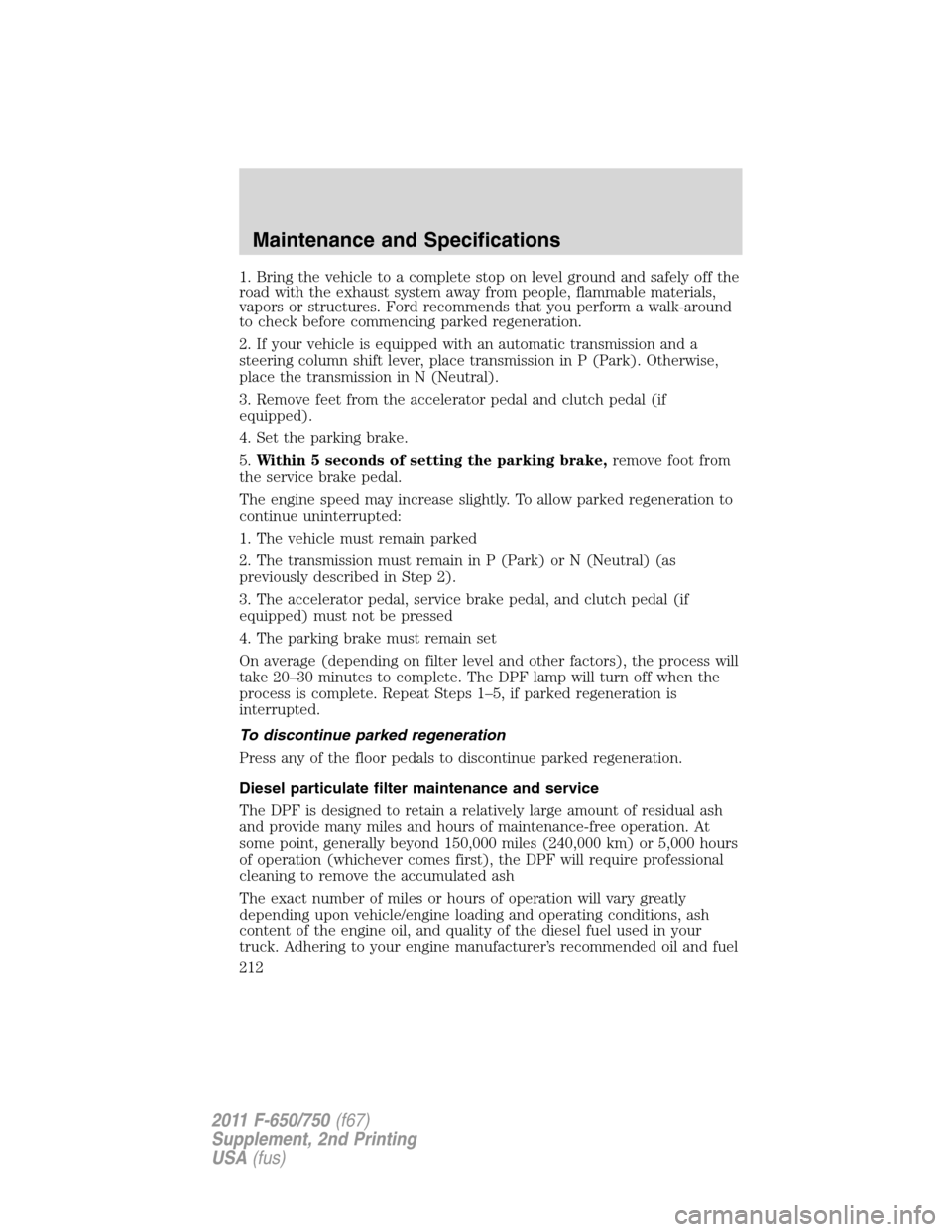
1. Bring the vehicle to a complete stop on level ground and safely off the
road with the exhaust system away from people, flammable materials,
vapors or structures. Ford recommends that you perform a walk-around
to check before commencing parked regeneration.
2. If your vehicle is equipped with an automatic transmission and a
steering column shift lever, place transmission in P (Park). Otherwise,
place the transmission in N (Neutral).
3. Remove feet from the accelerator pedal and clutch pedal (if
equipped).
4. Set the parking brake.
5.Within 5 seconds of setting the parking brake,remove foot from
the service brake pedal.
The engine speed may increase slightly. To allow parked regeneration to
continue uninterrupted:
1. The vehicle must remain parked
2. The transmission must remain in P (Park) or N (Neutral) (as
previously described in Step 2).
3. The accelerator pedal, service brake pedal, and clutch pedal (if
equipped) must not be pressed
4. The parking brake must remain set
On average (depending on filter level and other factors), the process will
take 20–30 minutes to complete. The DPF lamp will turn off when the
process is complete. Repeat Steps 1–5, if parked regeneration is
interrupted.
To discontinue parked regeneration
Press any of the floor pedals to discontinue parked regeneration.
Diesel particulate filter maintenance and service
The DPF is designed to retain a relatively large amount of residual ash
and provide many miles and hours of maintenance-free operation. At
some point, generally beyond 150,000 miles (240,000 km) or 5,000 hours
of operation (whichever comes first), the DPF will require professional
cleaning to remove the accumulated ash
The exact number of miles or hours of operation will vary greatly
depending upon vehicle/engine loading and operating conditions, ash
content of the engine oil, and quality of the diesel fuel used in your
truck. Adhering to your engine manufacturer’s recommended oil and fuel
Maintenance and Specifications
212
2011 F-650/750(f67)
Supplement, 2nd Printing
USA(fus)
Page 214 of 290
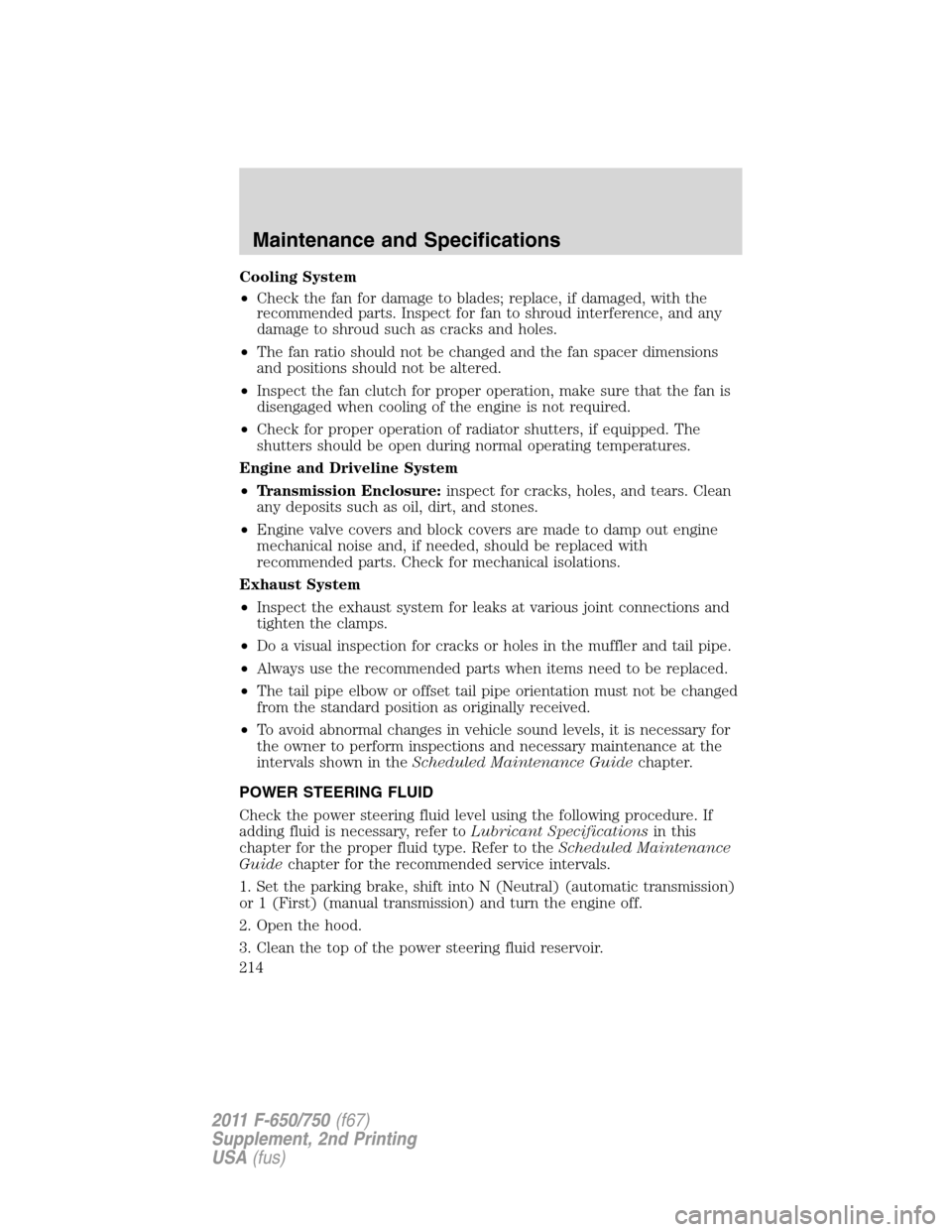
Cooling System
•Check the fan for damage to blades; replace, if damaged, with the
recommended parts. Inspect for fan to shroud interference, and any
damage to shroud such as cracks and holes.
•The fan ratio should not be changed and the fan spacer dimensions
and positions should not be altered.
•Inspect the fan clutch for proper operation, make sure that the fan is
disengaged when cooling of the engine is not required.
•Check for proper operation of radiator shutters, if equipped. The
shutters should be open during normal operating temperatures.
Engine and Driveline System
•Transmission Enclosure:inspect for cracks, holes, and tears. Clean
any deposits such as oil, dirt, and stones.
•Engine valve covers and block covers are made to damp out engine
mechanical noise and, if needed, should be replaced with
recommended parts. Check for mechanical isolations.
Exhaust System
•Inspect the exhaust system for leaks at various joint connections and
tighten the clamps.
•Do a visual inspection for cracks or holes in the muffler and tail pipe.
•Always use the recommended parts when items need to be replaced.
•The tail pipe elbow or offset tail pipe orientation must not be changed
from the standard position as originally received.
•To avoid abnormal changes in vehicle sound levels, it is necessary for
the owner to perform inspections and necessary maintenance at the
intervals shown in theScheduled Maintenance Guidechapter.
POWER STEERING FLUID
Check the power steering fluid level using the following procedure. If
adding fluid is necessary, refer toLubricant Specificationsin this
chapter for the proper fluid type. Refer to theScheduled Maintenance
Guidechapter for the recommended service intervals.
1. Set the parking brake, shift into N (Neutral) (automatic transmission)
or 1 (First) (manual transmission) and turn the engine off.
2. Open the hood.
3. Clean the top of the power steering fluid reservoir.
Maintenance and Specifications
214
2011 F-650/750(f67)
Supplement, 2nd Printing
USA(fus)
Page 257 of 290
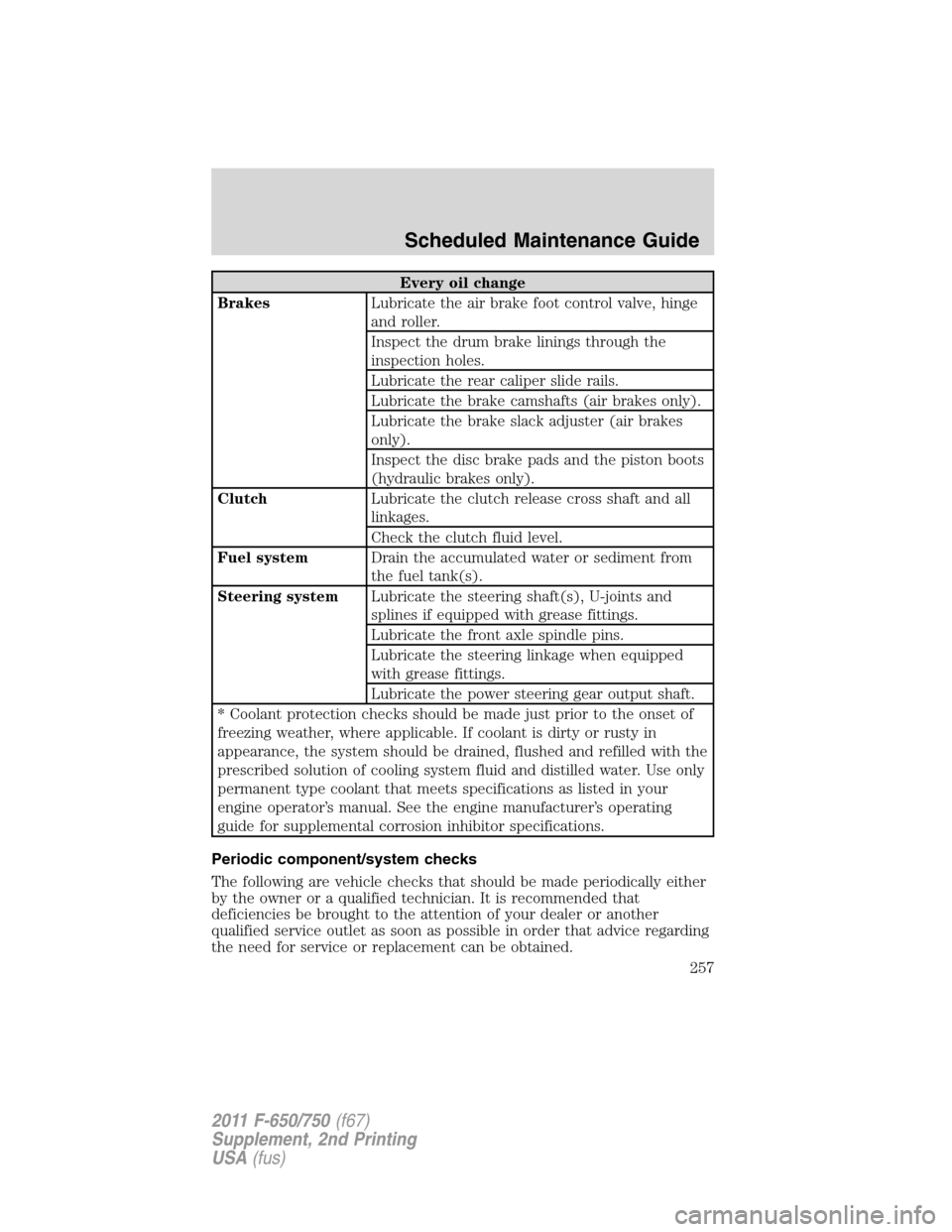
Every oil change
BrakesLubricate the air brake foot control valve, hinge
and roller.
Inspect the drum brake linings through the
inspection holes.
Lubricate the rear caliper slide rails.
Lubricate the brake camshafts (air brakes only).
Lubricate the brake slack adjuster (air brakes
only).
Inspect the disc brake pads and the piston boots
(hydraulic brakes only).
ClutchLubricate the clutch release cross shaft and all
linkages.
Check the clutch fluid level.
Fuel systemDrain the accumulated water or sediment from
the fuel tank(s).
Steering systemLubricate the steering shaft(s), U-joints and
splines if equipped with grease fittings.
Lubricate the front axle spindle pins.
Lubricate the steering linkage when equipped
with grease fittings.
Lubricate the power steering gear output shaft.
* Coolant protection checks should be made just prior to the onset of
freezing weather, where applicable. If coolant is dirty or rusty in
appearance, the system should be drained, flushed and refilled with the
prescribed solution of cooling system fluid and distilled water. Use only
permanent type coolant that meets specifications as listed in your
engine operator’s manual. See the engine manufacturer’s operating
guide for supplemental corrosion inhibitor specifications.
Periodic component/system checks
The following are vehicle checks that should be made periodically either
by the owner or a qualified technician. It is recommended that
deficiencies be brought to the attention of your dealer or another
qualified service outlet as soon as possible in order that advice regarding
the need for service or replacement can be obtained.
Scheduled Maintenance Guide
257
2011 F-650/750(f67)
Supplement, 2nd Printing
USA(fus)
Page 262 of 290
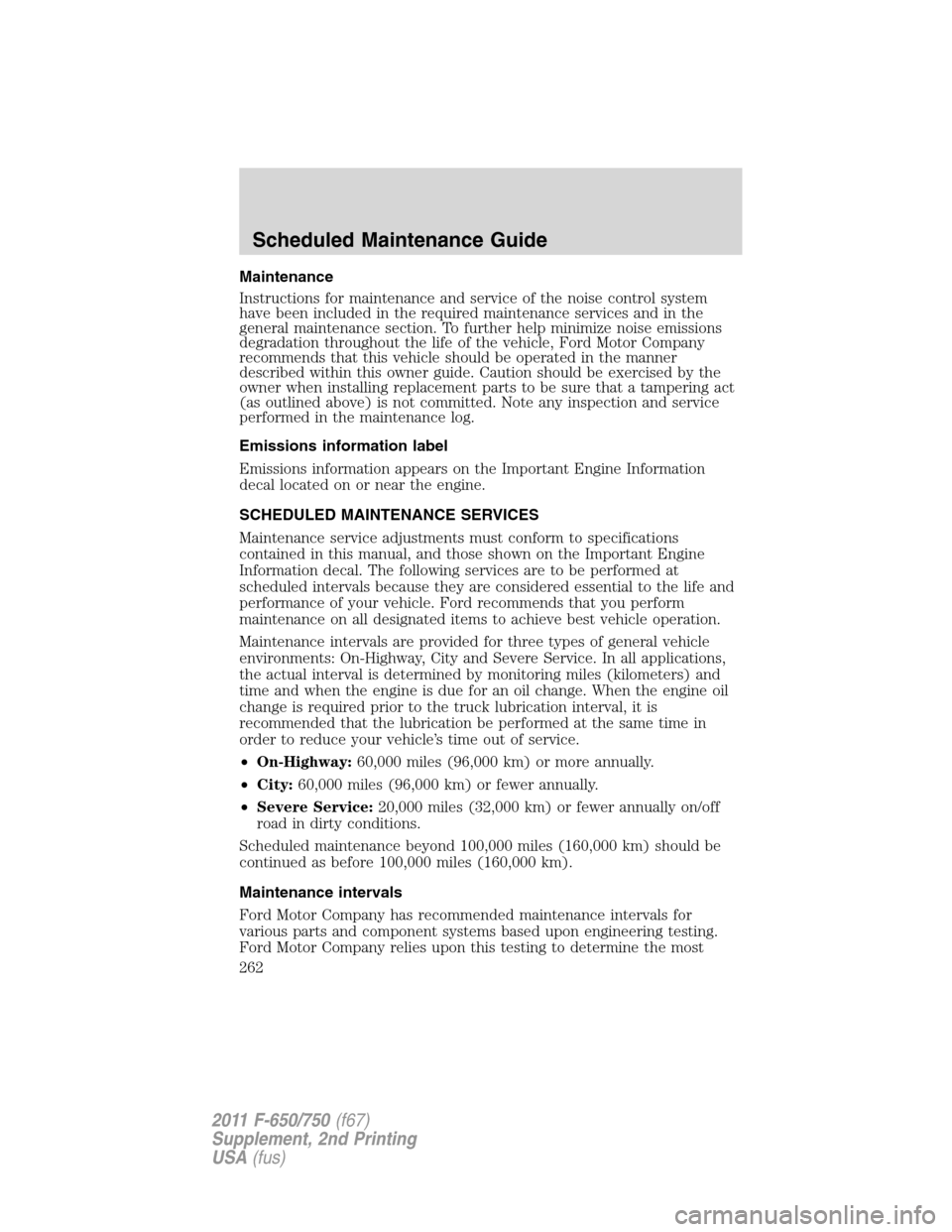
Maintenance
Instructions for maintenance and service of the noise control system
have been included in the required maintenance services and in the
general maintenance section. To further help minimize noise emissions
degradation throughout the life of the vehicle, Ford Motor Company
recommends that this vehicle should be operated in the manner
described within this owner guide. Caution should be exercised by the
owner when installing replacement parts to be sure that a tampering act
(as outlined above) is not committed. Note any inspection and service
performed in the maintenance log.
Emissions information label
Emissions information appears on the Important Engine Information
decal located on or near the engine.
SCHEDULED MAINTENANCE SERVICES
Maintenance service adjustments must conform to specifications
contained in this manual, and those shown on the Important Engine
Information decal. The following services are to be performed at
scheduled intervals because they are considered essential to the life and
performance of your vehicle. Ford recommends that you perform
maintenance on all designated items to achieve best vehicle operation.
Maintenance intervals are provided for three types of general vehicle
environments: On-Highway, City and Severe Service. In all applications,
the actual interval is determined by monitoring miles (kilometers) and
time and when the engine is due for an oil change. When the engine oil
change is required prior to the truck lubrication interval, it is
recommended that the lubrication be performed at the same time in
order to reduce your vehicle’s time out of service.
•On-Highway:60,000 miles (96,000 km) or more annually.
•City:60,000 miles (96,000 km) or fewer annually.
•Severe Service:20,000 miles (32,000 km) or fewer annually on/off
road in dirty conditions.
Scheduled maintenance beyond 100,000 miles (160,000 km) should be
continued as before 100,000 miles (160,000 km).
Maintenance intervals
Ford Motor Company has recommended maintenance intervals for
various parts and component systems based upon engineering testing.
Ford Motor Company relies upon this testing to determine the most
Scheduled Maintenance Guide
262
2011 F-650/750(f67)
Supplement, 2nd Printing
USA(fus)